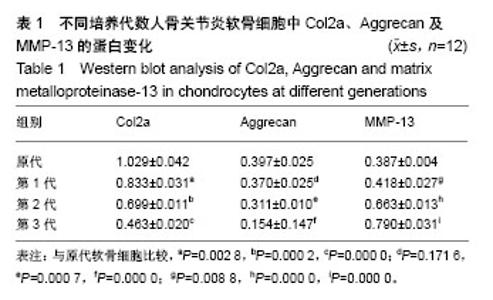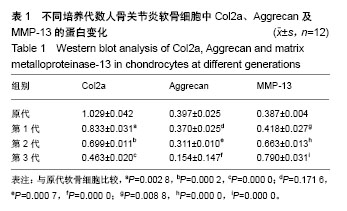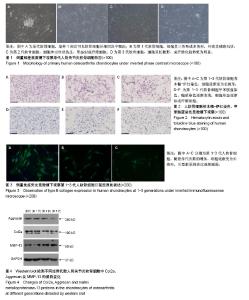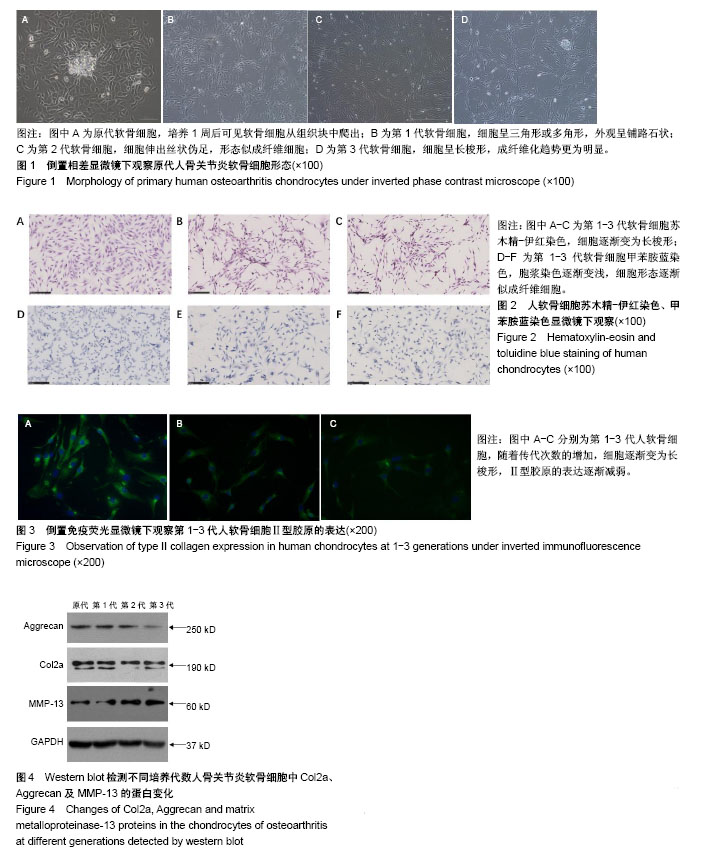| [1] Roberts BC, Thewlis D, Solomon LB, et al. Systematic mapping of the subchondral bone 3D microarchitecture in the human tibial plateau: Variations with joint alignment. J Orthop Res. 2017;35(9):1927-1941.[2] Appleton CT. Osteoarthritis year in review 2017: biology. Osteoarthritis Cartilage. 2018;26(3):296-303.[3] 谢平金,余翔,柴生颋,等.川芎嗪干预早期膝骨关节炎大鼠软骨Ⅱ型胶原纤维α1基因与血管内皮生长因子mRNA及miR20b的表达[J].中国组织工程研究, 2018,22(12):1846-1851.[4] 欧阳家耀,张海严,方航,等.小鼠软骨前体细胞ATDC5中沉默骨膜蛋白基因能延缓软骨退变[J].中华实验外科杂志, 2018, 35(1):15-18.[5] 刘明东,盛天金,王万宗.胰蛋白酶及Ⅱ型胶原酶消化获取关节软骨细胞[J].中国组织工程研究,2010, 14(46):8551-8554.[6] Altman R, Asch E, Bloch D, et al. Development of criteria for the classification and reporting of osteoarthritis. Classification of osteoarthritis of the knee. Diagnostic and Therapeutic Criteria Committee of the American Rheumatism Association. Arthritis Rheum. 1986;29(8):1039-1049.[7] 邓林峡,余慕雪,潘思年,等.比较单独消化法及分步消化法培养新生大鼠原代软骨细胞的生物学特性[J].中国组织工程研究, 2018,22(25):4047-4052.[8] 杨物鹏,许建中.软骨细胞培养及其调控[J].中国矫形外科杂志, 2000,7(8):800-803.[9] Lu Y, Dhanaraj S, Wang Z, et al. Minced cartilage without cell culture serves as an effective intraoperative cell source for cartilage repair. J Orthop Res. 2006;24(6):1261-1270.[10] 唐新,郑果,黄强,等.人骨关节炎软骨细胞的体外培养及细胞形态学分析[J].实用骨科杂志,2015,21(7):614-618.[11] Filip A, Pinzano A, Bianchi A, et al. Expression of the semicarbazide-sensitive amine oxidase in articular cartilage: its role in terminal differentiation of chondrocytes in rat and human. Osteoarthritis Cartilage. 2016;24(7):1223-1234.[12] Manning WK, Bonner WM Jr. Isolation and culture of chondrocytes from human adult articular cartilage. Arthritis Rheum. 1967;10(3):235-239.[13] Green WT Jr. Behavior of articular chondrocytes in cell culture. Clin Orthop Relat Res. 1971;75:248-260.[14] Klagsbrun M. Large-scale preparation of chondrocytes. Methods Enzymol. 1979;58:560-564.[15] 童迅,赵海恩,张栋,等.人关节软骨细胞的体外分离、培养与鉴定[J].现代生物医学进展,2012,12(16):3040-3044.[16] Darling EM, Pritchett PE, Evans BA, et al. Mechanical properties and gene expression of chondrocytes on micropatterned substrates following dedifferentiation in monolayer. Cell Mol Bioeng. 2009;2(3):395-404.[17] 童迅,贠喆,张栋,等.人正常及骨关节炎软骨细胞体外培养的对照研究[J].现代生物医学进展, 2013,13(24):4648-4653.[18] 胡炯,李笑颜,邓廉夫,等.人正常软骨细胞和骨性关节炎软骨细胞体外培养对照研究[J].中国中医骨伤科杂志, 2010,18(10):8-12.[19] Kokubo M, Sato M, Yamato M, et al. Characterization of layered chondrocyte sheets created in a co-culture system with synoviocytes in a hypoxic environment. J Tissue Eng Regen Med. 2017;11(10):2885-2894.[20] Qi WN, Scully SP. Extracellular collagen regulates expression of transforming growth factor-beta1 gene. J Orthop Res. 2000;18(6):928-932.[21] Yik JH, Hu Z, Kumari R, et al. Cyclin-dependent kinase 9 inhibition protects cartilage from the catabolic effects of proinflammatory cytokines. Arthritis Rheumatol. 2014;66(6):1537-1546.[22] Shiomi T, Lemaître V, D'Armiento J, et al. Matrix metalloproteinases, a disintegrin and metalloproteinases, and a disintegrin and metalloproteinases with thrombospondin motifs in non-neoplastic diseases. Pathol Int. 2010;60(7):477-496.[23] Wang M, Sampson ER, Jin H, et al. MMP13 is a critical target gene during the progression of osteoarthritis. Arthritis Res Ther. 2013;15(1):R5.[24] Ruan G, Xu J, Wang K, et al. Associations between knee structural measures, circulating inflammatory factors and MMP13 in patients with knee osteoarthritis. Osteoarthritis Cartilage. 2018;26(8):1063-1069.[25] Li H, Wang D, Yuan Y, et al. New insights on the MMP-13 regulatory network in the pathogenesis of early osteoarthritis. Arthritis Res Ther. 2017;19(1):248. |



